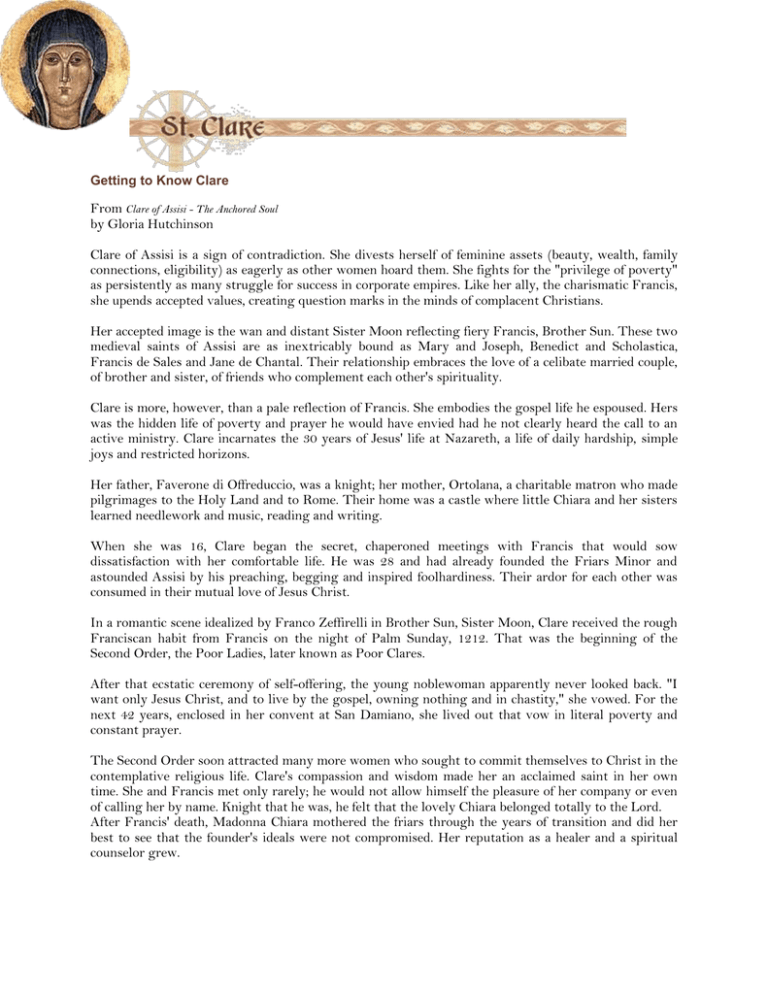From by Gloria Hutchinson
advertisement

Getting to Know Clare From Clare of Assisi - The Anchored Soul by Gloria Hutchinson Clare of Assisi is a sign of contradiction. She divests herself of feminine assets (beauty, wealth, family connections, eligibility) as eagerly as other women hoard them. She fights for the "privilege of poverty" as persistently as many struggle for success in corporate empires. Like her ally, the charismatic Francis, she upends accepted values, creating question marks in the minds of complacent Christians. Her accepted image is the wan and distant Sister Moon reflecting fiery Francis, Brother Sun. These two medieval saints of Assisi are as inextricably bound as Mary and Joseph, Benedict and Scholastica, Francis de Sales and Jane de Chantal. Their relationship embraces the love of a celibate married couple, of brother and sister, of friends who complement each other's spirituality. Clare is more, however, than a pale reflection of Francis. She embodies the gospel life he espoused. Hers was the hidden life of poverty and prayer he would have envied had he not clearly heard the call to an active ministry. Clare incarnates the 30 years of Jesus' life at Nazareth, a life of daily hardship, simple joys and restricted horizons. Her father, Faverone di Offreduccio, was a knight; her mother, Ortolana, a charitable matron who made pilgrimages to the Holy Land and to Rome. Their home was a castle where little Chiara and her sisters learned needlework and music, reading and writing. When she was 16, Clare began the secret, chaperoned meetings with Francis that would sow dissatisfaction with her comfortable life. He was 28 and had already founded the Friars Minor and astounded Assisi by his preaching, begging and inspired foolhardiness. Their ardor for each other was consumed in their mutual love of Jesus Christ. In a romantic scene idealized by Franco Zeffirelli in Brother Sun, Sister Moon, Clare received the rough Franciscan habit from Francis on the night of Palm Sunday, 1212. That was the beginning of the Second Order, the Poor Ladies, later known as Poor Clares. After that ecstatic ceremony of self-offering, the young noblewoman apparently never looked back. "I want only Jesus Christ, and to live by the gospel, owning nothing and in chastity," she vowed. For the next 42 years, enclosed in her convent at San Damiano, she lived out that vow in literal poverty and constant prayer. The Second Order soon attracted many more women who sought to commit themselves to Christ in the contemplative religious life. Clare's compassion and wisdom made her an acclaimed saint in her own time. She and Francis met only rarely; he would not allow himself the pleasure of her company or even of calling her by name. Knight that he was, he felt that the lovely Chiara belonged totally to the Lord. After Francis' death, Madonna Chiara mothered the friars through the years of transition and did her best to see that the founder's ideals were not compromised. Her reputation as a healer and a spiritual counselor grew. Among those who confided in her and counted on her prayers were two popes, Gregory IX and Innocent IV. While the former had tried to convince Clare to accept a less rigorous mode of poverty, the latter, at her persistent request, confirmed the "privilege of seraphic poverty" shortly before her death. This pontiff said of her, "She has surpassed all women of her time." The depth of Clare's union with Christ is evident in a letter she wrote to Agnes of Prague, who founded a monastery of the Second Order in that city: His affection holds one fast; his contemplation is like a breath of new life. His kindness fills one to the brim; his sweetness is in overflowing measure. The recollection of him shines with a soft light. His fragrance revives the dead... Now, since he is the splendor of eternal glory and the brightness of everlasting light and the mirror without spot (Wis 7:26)..., look steadfastly into this mirror every day. See in it every time you look -and look into it always -your own face (Letter IV, translation by Father David Temple, O.F.M.) Although it is tempting to see Clare as a purely feminine, passive, reflective person, that characterization would be incomplete. Her life at San Damiano was as rigorous as that of any monk or peasant farmer. Raised in a castle, she lived her entire adult life in a small stone convent, slept on a straw mattress, fasted three days a week, never ate meat, often did penance, and got up in the middle of the night to pray the Divine Office. Year around she wore a coarse brown robe with a black veil and went barefoot on stone floors. Thomas of Celano, her biographer, observed that Clare was of good stature and had an oval face, fine coloring and fair hair. His masculine judgment was that "she inclined to stoutness, but nowise excess." In early paintings, however, Clare is always tall and slender, perhaps like the candle her name suggested. Members of her community who testified during the canonization process emphasized the abbess' circumspect leadership: "She often hastened to do herself what she had commanded another to do." They described the humility that led her to wash the extern sisters' feet on their return from a round of begging as well as her love of silence ("Careless speech always weakens our love for God," she insisted.) Her devotion to Christ in his Passion was evidenced in all-night vigils and weeping during the hours of the Crucifixion. Chronically ill, she healed others of sickness and depression by signing them with the cross. Clare called herself the "little plant of the Blessed Francis," and she relied on him as her spiritual director in the early years of her life as a religious. He was wise enough to lead her through a gradual liberation until Christ himself was her only guide. Her devotion toward Francis ripened into a mature love that did not require his physical presence. In a symbolic vision that underscores the motherly nature of both saints, Clare saw herself climbing a high stairway and carrying a jug of hot water with a towel for Francis. When she reached him, he opened his habit to bare his chest so that she might drink "something sweet and delightful." While Clare and Francis shared the same gospel insights, she received the gift he desired for himself but which he could enjoy only at intervals: She was the contemplative flowering in a cloister garden, the prayerful person whose daily life was focused on God alone.




